

Timetoast Timelines. Evidence for Plate Tectonics: DLESE Teaching Box. Plate Tectonics - Pacific Plate Movement. Plate Tectonics. Lesson Summary Overview According to the theory of plate tectonics, Earth's crust is composed of a number of individual plates that change shape and position over time.
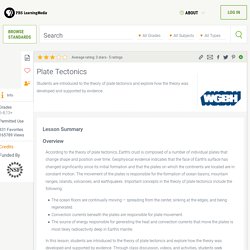
Geophysical evidence indicates that the face of Earth's surface has changed significantly since its initial formation and that the plates on which the continents are located are in constant motion. GCSE Bitesize: Plate tectonics activity. Plate Tectonics - Earth Like a Puzzle - Children learn about plate tectonics, earthquakes, and volcanoes at this site in Scripps Institution of Oceanography. By Nan Criqui Most people know that Earth is moving around the Sun and that it is constantly spinning.
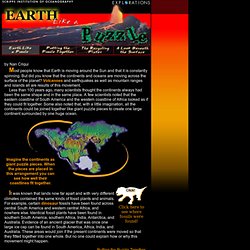
But did you know that the continents and oceans are moving across the surface of the planet? Volcanoes and earthquakes as well as mountain ranges and islands all are results of this movement. Less than 100 years ago, many scientists thought the continents always had been the same shape and in the same place. A few scientists noted that the eastern coastline of South America and the western coastline of Africa looked as if they could fit together. Putting the Puzzle Together... Cracking Up: Plate Tectonics, Volcanism, and the Structure of the Earth.
Model the structural layers of the Earth, investigate the data that led to the theory of plate tectonics, and discover the relationship between plate tectonics and earthquakes, volcanos, and mountains, through data analysis and hands-on activities.
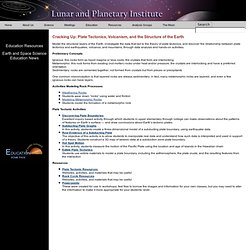
Preliminary Concepts Igneous: this rocks form as liquid magma or lava cools; the crystals that form are interlocking Metamorphic: this rock forms from existing (not molten) rocks under heat and/or pressure; the crystals are interlocking and have a preferred orientation Sedimentary: rocks are cemented together; not formed from crystals but from pieces or precipitants One common misconception is that layered rocks are always sedimentary; in fact, many metamorphic rocks are layered, and even a few igneous rocks can have layers.
Activities Modeling Rock Processes Plate Tectonic Activities Resources. Discovering Plate Boundaries Home. Alfred Wegener: Great Minds. Wegener's Puzzling Evidence Exercise (6th Grade) Although Alfred Wegener was not the first to suggest that continents have moved about the Earth, his presentation of carefully compiled evidence for continental drift inspired decades of scientific debate.
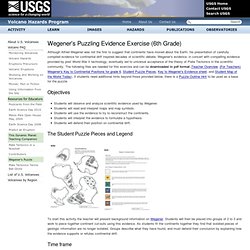
Wegener's evidence, in concert with compelling evidence provided by post World War II technology, eventually led to universal acceptance of the theory of Plate Tectonics in the scientific community. The following files are needed for this exercise and can be downloaded in pdf format (Teacher Overview, (For Teachers) Wegener's Key to Continental Positions for grade 6, Student Puzzle Pieces, Key to Wegener's Evidence sheet, and Student Map of the World Today).
If students need additional hints beyond those provided below, there is a Puzzle Outline Hint to be used as a base for the puzzle. Objectives Students will observe and analyze scientific evidence used by Wegener. A Plate Tectonics Puzzle. Gondwanaland. Continental Drift Activity (SEPUP) SEPUP Continental Drift. When Continental Drift Was Considered Pseudoscience. January 6, 1912: Continental Drift! “Beautiful is what we see, More beautiful is what we understand, Most beautiful is what we do not comprehend.”
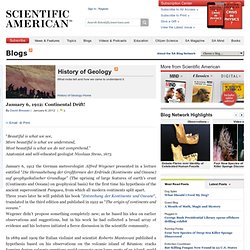
Anatomist and self-educated geologist Nicolaus Steno, 1673 January 6, 1912 the German meteorologist Alfred Wegener presented in a lecture entitled “Die Heraushebung der Großformen der Erdrinde (Kontinente und Ozeane) auf geophysikalischer Grundlage” (The uprising of large features of earth’s crust (Continents and Oceans) on geophysical basis) for the first time his hypothesis of the ancient supercontinent Pangaea, from which all modern continents split apart. Three years later he will publish his book “Entstehung der Kontinente und Ozeane“, translated in the third edition and published in 1922 as “The origin of continents and oceans.”
Wegener didn’t propose something completely new; as he based his idea on earlier observations and suggestions, but in his work he had collected a broad array of evidence and his lectures initiated a fierce discussion in the scientific community. The Origins of Continents. Geology 101 Lab: Plate Tectonics. Exploring Earth Visualizations. A Science Odyssey: You Try It: Plate Tectonics. PhET Lab: Plate Tectonics. Topics Plate Tectonics Crust Lithosphere Mantle Density Buoyancy Earth Science Description Explore how plates move on the surface of the earth.
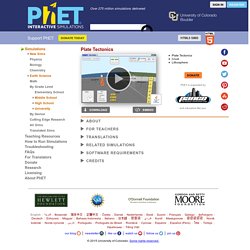
Change temperature, composition, and thickness of plates. Discover how to create new mountains, volcanoes, or oceans! Sample Learning Goals Describe the differences between oceanic and continental crust, including their respective properties of density, composition, temperature and thickness.Predict how changes in composition and temperature change crust density and buoyancy.Draw a time series for different types of plate boundaries and their motions, indicating the related surface features.Deduce the type of plate boundary given images or descriptions of surface features.Explain which types of plate boundaries create crust, and which destroy crust Version 1.02.
Dynamic Earth . Plate Tectonics. Plate Tectonics Animation. Virtual Lab for make up of ocean floor. Continental Drift Virtual Lab.